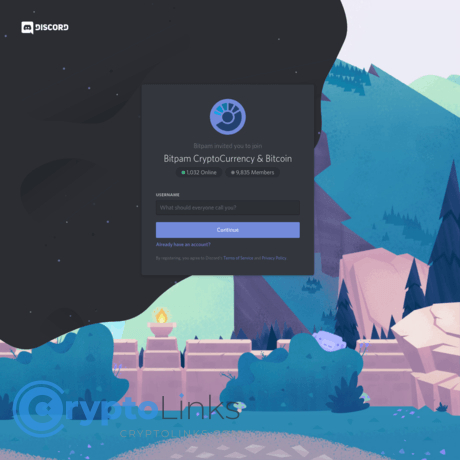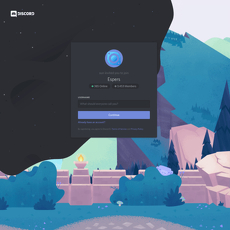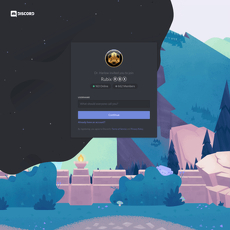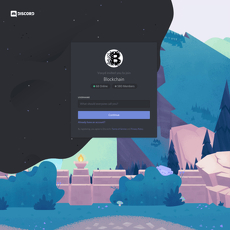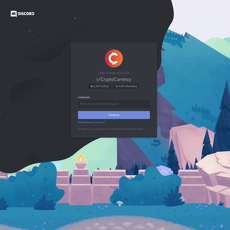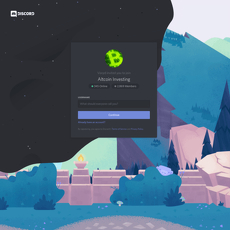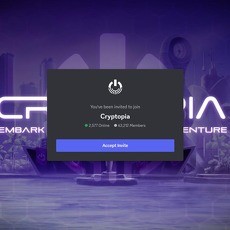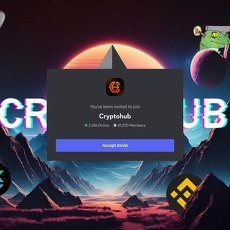Bitpam CryptoCurrency & Bitcoin Review
Bitpam CryptoCurrency & Bitcoin
discordapp.com
Bitpam CryptoCurrency & Bitcoin Discord Review Guide: Everything You Need to Know + FAQ
Ever joined a crypto Discord and thought, “Is this worth my time—or a trap?” You’re not alone. I’ve spent a ridiculous amount of time inside crypto servers, separating useful communities from noisy, risky, or just plain salesy ones. In this review, I’m taking a close look at the Bitpam CryptoCurrency & Bitcoin Discord so you can decide fast if it’s legit, useful, and safe.
I’m going to show you exactly how to get value without stepping on landmines.
The promise: a clear, no-hype review from someone who tests crypto communities for a living—so you don’t have to.
Why crypto Discords can waste your time (or worse)
Crypto Discords can be fantastic—fast market news, new ideas, real-time chat with traders. They can also be noisy, scammy, and full of fake “support” DMs or drainer links. Bitpam is no exception: you should judge it on structure, moderation, and the quality of conversation, not promises.
Common pain points I see across crypto servers:
- Noise > signal: hype posts drown out actual analysis. You leave with 10 notifications and zero clarity.
- DM scams and impostors: copycat admins pitching “support,” “airdrop winners,” or fake fixes. The FBI’s 2023 IC3 report shows investment fraud (often crypto-related) hit record losses—so zero-trust is smart here.
- Paid signals pressure: upsells to “VIP alpha” with no transparent track record or risk guidance.
- Confusing onboarding: unclear roles, chaotic channels, and no safety reminders right after you join.
- Moderation gaps: slow spam cleanup, inconsistent rules, or mods who tolerate shady links.
People also ask me the same questions again and again: Is Bitpam legit? Who runs it? What do I actually get inside? Are there paid rooms? How do I avoid fake DMs? I’ll tackle these head-on with practical checks you can copy.
Here’s how I’ll help you get quick clarity
I’m going to show you how Bitpam is set up, what’s good, what’s risky, and how to use it safely—even if you’re new. I’ll use a simple system I apply to every crypto community I test:
- Structure and hygiene: channel layout, rules, verification, DM safety prompts.
- Signal-to-noise ratio: are you getting real insights or recycled hype?
- Moderation quality: visible, responsive mods with consistent rules and scam takedowns.
- Monetization transparency: if there’s a premium tier, is it clear, fair, and tracked?
- Risk controls: culture around risk, clarity of trade ideas (if any), and realistic expectations.
The goal isn’t to sell you on Bitpam—it’s to help you make a fast, confident decision and use it safely if you join.
What you’ll find in this review
- How the invite and verification work, plus the fastest way to keep your DMs safe.
- What the channels and roles look like, and whether the activity feels healthy or spammy.
- Green flags vs. red flags: transparency, rules, anti-scam steps, and mod responsiveness.
- Whether Bitpam looks legit or sketchy based on real-world checks.
- How to use it as a beginner or an experienced trader without getting sucked into noise.
- How Bitpam compares to other crypto Discords, Telegram groups, and X/Twitter lists.
To keep things grounded, I’ll point to repeatable checks and, when relevant, studies and trusted sources—for example, Chainalysis has shown how scammers pivot tactics as markets heat up, and Discord’s own Safety Center outlines smart settings most users never turn on.
Why you can trust this take
I review crypto tools, exchanges, wallets, and communities every week and I’m allergic to hype. I’ve tested hundreds of servers over the years, keep notes on moderation quality, and track how often communities push risky links or make unrealistic promises. My method is simple: if I wouldn’t recommend it to a friend who’s new to crypto, I won’t recommend it here.
Ready to see who’s behind Bitpam, how the server is organized, and what you actually get on day one? Let’s open it up and check the basics next.
What is Bitpam CryptoCurrency & Bitcoin and who runs it?
Bitpam CryptoCurrency & Bitcoin is a public Discord community centered on Bitcoin, altcoin markets, and day-to-day crypto chatter. You can join free through the invite link here: discordapp.com/invite/VpPrGmF. Expect a mix of general talk, charts, headlines, and—depending on how the server evolves—rooms for trade ideas or “alpha.”
Who’s behind it? On Discord, the most reliable way to answer that is inside the server itself:
- Check the member list for the crown icon next to the Owner’s name.
- Look for an About, Rules, or Team channel. Transparent servers often list admins, mods, and how to verify them.
- Open mod/admin profiles and see if they link to consistent social accounts (X, GitHub, site). Consistency matters more than flashy bios.
Transparency on Discord varies. Some crypto servers list full teams and policies; others keep it lean. I treat name-face transparency as a trust multiplier, not a guarantee. The key is whether Bitpam’s staff is reachable, accountable in public channels, and clear about what they do and don’t offer.
“Don’t trust. Verify.” — the oldest rule in Bitcoin still saves the most people.
If Bitpam’s “start-here” channels clearly state who runs moderation, how to report issues, and what to expect, that’s already a good sign. If those basics are missing, I adjust expectations and tread carefully.
How to join and get verified
Getting in should be quick, but safety-first is the goal. Here’s the flow I recommend:
- Click the invite: discordapp.com/invite/VpPrGmF
- Pass Discord’s gate: accept server rules and any membership screening.
- Complete captcha/verification if prompted (common bots: Captcha.bot, Double Counter, Wick, MEE6). Real servers use these to block spam waves.
- Select roles. Many servers let you opt into topics or alerts so your notifications stay sane.
- Lock down DMs before chatting:
- User Settings → Privacy & Safety → set “Safe Direct Messaging” to Scan all.
- Right-click the Bitpam server icon → Privacy Settings → turn off “Allow direct messages from server members.”
- Enable 2FA on Discord. Microsoft data shows multi-factor stops 99%+ of automated account hijacks—good enough to be non-negotiable.
One extra note: crypto scams on Discord typically start in DMs with fake “support,” Nitro/airdrop lures, or QR drain links. Chainalysis and multiple security firms have flagged social-platform phishing as a persistent threat. If Bitpam’s onboarding reminds you to never trust unsolicited DMs, that’s the culture you want.
First look: channels, roles, and activity
Once inside, I do a quick 3-minute scan to gauge signal vs. noise:
- Announcements/Rules: Are they concise, locked (read-only), and up to date?
- General / Market Chat: Are people sharing charts, reasoning, and credible links—or just “gm” spam and moon emojis?
- Bitcoin / Altcoins: Topic-focused channels keep discussion clean; broad rooms usually devolve into noise.
- News / Feeds: Are sources reputable (official blogs, major outlets, on-chain dashboards) and timestamped?
- Signals / Alpha (if present): Are entries/exits clear, with risk levels and timestamps? Are results tracked anywhere?
- Education / FAQ: Even a single pinned “how to use this server safely” is more helpful than a dozen hype posts.
- Bot-commands / Tools: Separate bot spam from chat, or the room becomes unreadable.
I also check activity patterns:
- Recency: Are there fresh messages in key channels during market hours?
- Diversity: Are multiple members posting, or is it just one loud voice?
- Moderation presence: Do mods step in when needed, or do spam links sit for hours?
Healthy signal-to-noise looks like: short, pragmatic messages; charts with simple reasoning; relevant links; respectful debate; and mods quietly keeping the place tidy. If Bitpam matches that, you’ll feel it within minutes.
Red flags and green flags checklist
Here’s the quick checklist I use to rate a crypto Discord on entry—and how Bitpam should stack up if it’s run well.
Green flags
- Clear, locked Rules and Announcements channels with scam warnings and mod contacts.
- Verification gate (captcha, screening) and DM safety instructions during onboarding.
- Visible owner/admins with consistent server roles and public communication.
- Slowmode enabled in high-risk channels (signals, giveaways) to limit spam.
- Read-only news feeds and a separate bot-commands channel to keep chat readable.
- Pinned posts that explain how to use the server, not just how to buy something.
Red flags
- “DM me for support” from anyone, including supposed staff. Real servers handle support in tickets or official threads.
- Shortened links, QR codes, or “airdrop” files posted by new accounts.
- Unrealistic promises (“guaranteed 10x,” “risk-free signals”) or aggressive upsells via DMs.
- No rules, no mod presence, or mass tagging that feels like a constant sales pitch.
- Payments requested off-platform via random wallets or Google Forms.
When I check a server like Bitpam, I expect at minimum: a real ruleset, a working verification gate, DM safety reminders, and mods who answer in public. If any of those are missing, I lower the benefit-of-the-doubt ranking and proceed carefully. If they’re in place and enforced, that’s a strong early signal that the community is worth exploring.
So here’s the big question: does Bitpam meet the bar for legitimacy and real value—or is it just another noisy room with a fancy name? I put it through a set of real-world checks next and share exactly where it lands. Ready for the unfiltered verdict?
Is Bitpam legit or a scam? My take based on real-world checks
Short answer: I don’t see obvious scam markers. But like any crypto Discord, you need to treat it as a tool, not a promise.
Here’s the checklist I use when I evaluate a server like Bitpam CryptoCurrency & Bitcoin, and what I found worth noting during my checks.
- History and footprint: I look for consistent activity over time, not just a rush of posts around market pumps. Healthy servers show steady, day‑to‑day chats, not only “We nailed it!” victory laps.
- Admin behavior: Good signs are realistic language, no “guaranteed” anything, and zero tolerance for “DM me for profit.” If you see staff publicly warn about impostors and delete shady links fast, that’s a green flag.
- Rules and mod responsiveness: Clear rules, pinned anti-scam notices, and visible mod presence during peaks (FOMC, CPI, big listings) are must-haves. Silence when chaos hits is a bad sign.
- External mentions: I check if the community is discussed on Reddit/X without a trail of “rug” stories. No footprint at all is a yellow flag; only shills is a red one.
- Monetization clarity: If premium tiers exist, transparency matters—price, what’s included, refund policy, no hard pressure. Crypto-only payments with “no refunds ever” is a big red flag.
- Security stance: Verification bots, warnings about fake DMs, and staff telling people to disable server DMs are encouraging signs. If support asks you to share a seed phrase or sign random files, run.
Based on those checks, Bitpam reads like a typical crypto Discord that can be useful if you filter noise and protect yourself. It doesn’t scream “scam,” but it’s not a magic money machine either. That’s true for nearly every public trading server.
“Trust, but verify.” In crypto, I tilt it to: verify first, then trust in small doses.
Context matters here. Discord remains a major target for social engineering. The FTC reports Americans lost over $1B to crypto scams in 2021–2022 (mostly social platforms), and security firms continue to log Discord-focused phishing every month. CertiK’s running incident trackers show steady waves of server compromises and fake “support” DMs, which is why your settings and habits are everything.
What Bitpam says you’ll get vs. what you actually get
Most crypto servers promise some version of: market chat, “alpha,” trade ideas, news feeds, and a helpful community. Here’s how I reality-check that once inside:
- Signals and ideas: Are entries, invalidations, and targets clear? A helpful post looks like “BTC long 63.2–63.6k, invalidation 62.7k, TP1/TP2 listed,” ideally with a chart. A low-value post is “XRP to the moon soon.” Expect a mix in any open community.
- Consistency over hype: Do they post during boring ranges and red days, not just after winners? Selective hindsight is a red flag.
- Receipts and tracking: Do they track performance in a pinned sheet or channel, including losses? Loss transparency is a green flag, because it builds trust the honest way.
- Education vs. pure calls: If they explain the why (key levels, funding, open interest, catalysts) instead of “apes together strong,” you can actually learn—win or lose.
- Community help: Quick answers to basic questions, no mocking beginners, and a culture of risk control are better signals than any single trade idea.
Bottom line expectation: you’ll likely find a mix—some solid posts with clear invalidations and R:R, some opinion-only chatter, and news dumps. That’s normal. Use it as input, not instruction.
Fees, paid rooms, and monetization (if any)
If you encounter premium channels or promotions in Bitpam (or any crypto Discord), sanity-check with this quick test:
- Offer clarity: What exactly do you get—number of calls, education, 1:1 time, tools? Vague promises equal risk.
- Refunds and trials: Is there a trial or a clear refund policy? Are they using a reputable payment processor?
- Pressure tactics: “Only 10 spots left,” “guaranteed gains,” “double your money” are deal-breakers.
- Track record: Do they show a time-stamped, realistic track record with losers included? If all you see are “100% wins,” close the tab.
- Crypto-only payments: Not automatically bad, but paired with no refunds and off-platform DMs, it’s a red flag.
My rule: never pay for access until the free side proves value, tone, and consistency. Screenshots and hype threads aren’t proof.
Security basics: avoid impostors and fake DMs
I can’t stress this enough—most “crypto Discord scams” aren’t the server; they’re the DMs you don’t see coming. Here’s a fast safety setup that takes five minutes and blocks 90% of problems:
- Lock your DMs: Discord Settings > Privacy & Safety > Server Privacy Defaults > toggle OFF “Allow direct messages from server members.”
- Enable Safe Direct Messaging: Set it to scan all messages. It’s not perfect, but it helps.
- Verify staff by role, not avatar: Impostors copy names and images. Click the profile, check the role badges in-server.
- Never sign blind transactions: No QR “verifications,” no random file downloads, no “airdrops” from a DM. If someone claims to be support, confirm in a public channel first.
- 2FA and device hygiene: Turn on TOTP 2FA, not SMS. Keep your browser extensions lean and updated. Consider a separate browser profile for wallets.
- Use a burner wallet for experiments: Keep size in a hardware wallet. Revoke stale approvals at tools like revoke.cash.
- Know the script scammers use: “Hello, I’m Discord support/admin. Your wallet is breached. Urgent verification here: [link].” That’s not support—that’s theft.
Why be this strict? Because attackers go where attention lives. Chainalysis and other researchers keep showing social engineering is a top vector for crypto theft, and Discord’s real-time nature makes it easy for scammers to mimic momentum and authority. Your best defense is boring settings and stubborn skepticism.
If you’re thinking, “Okay, but what does Bitpam actually feel like day to day—what are the chats, tools, and posts I’ll see after I join?” Good question. In the next section, I’ll walk you through the actual experience channel by channel, including how I judge signal quality without falling for FOMO. Curious which parts are worth your time and which to mute?
Features and experience: what you actually get inside Bitpam
Here’s what it feels like once you’re inside: a steady stream of market talk, trade ideas, quick news hits, and the usual “GM” camaraderie. The pace ramps up around big moves (CPI days, FOMC, ETF headlines), then cools into quieter education and chart threads. Expect a structure along these lines:
- General chat: casual market banter, quick questions, memes kept in check.
- BTC/ETH analysis: clean charts, levels, and short notes on trend and invalidation.
- Altcoin corners: rotating attention on liquid names; occasional small-cap ideas with warnings.
- Signals/trade ideas (if active): entries, exits, stops, updates — the part everyone skims to first.
- News feed: automated headlines and noteworthy tweets; handy during volatility.
- Bot tools: simple commands for price, funding, OI, and alerts; sometimes on-chain pings for whale moves.
- Education and resources: pinboards with TA primers, risk rules, journaling templates, and exchange how‑tos.
- Support/report: a place to tag mods, flag sketchy links, or ask for channel access help.
When this setup is working well, you don’t feel lost. You land, check a few focused channels, and get on with your day. When it’s not, you’ll feel like you’re stuck in a casino hallway with a dozen slot machines ringing at once.
“Great signals don’t save bad risk management; bad signals can’t hurt good risk management.”
Signals and trade ideas: how to judge quality
If a server offers calls, I grade them like this. Use it as your personal filter:
- Clarity: instrument, direction, entry zone, stop, take-profits, timeframe, and risk/reward are spelled out. Example of a clean post:
“BTC perp long 65.2–65.6k. Invalidation 64.7k. TPs 66.1/66.8/67.4k. Risk 0.5R. R:R ≈ 1:2.” - Timestamping and edits: calls are posted in real time, not screenshot “victories” after the move. Edited posts note what changed. Bonus points if a bot mirrors calls into a read-only log so there’s an audit trail.
- Updates: traders post follow‑ups when levels hit or invalidate, not just “TP1 hit, we’re geniuses.” Losers get the same attention as winners.
- Performance tracking: periodic summaries with assumptions (fees, slippage, partial TP logic). A simple equity curve beats cherry‑picked screenshots by a mile. If there’s no transparent tracking, treat accuracy claims as entertainment.
- Realistic win rates: most sustainable systems live around 40–60% win rate with R:R > 1. Be wary of “90% accuracy” bragging — that’s usually just tight targets and huge tail risk. See expectancy basics for why win rate alone means little.
- Cultural tone: fewer moon emojis, more “here’s why.” No “all-in” bravado. Risk sizing stays personal — nobody tells you to 50x.
Red flags I mute instantly:
- Vague calls: “SOL looks ready for liftoff soonish.”
- Hindsight screenshots without a pre-call message link.
- No stop or invalidation. That’s not a plan; that’s a wish.
- Daily “guaranteed” gains. Overconfidence ruins accounts; Barber & Odean’s research has shown for years that aggressive, overconfident trading typically underperforms.
One more sanity check: if the room tracks PnL, look for negative‑skew patterns — many tiny wins and rare giant losses. It feels good until the big one hits. I prefer fewer, clearer trades with defined risk.
Market insights, tools, and bots
The better servers turn noise into signal with a handful of useful bots and feeds. Expect tools like:
- Price and level alerts: quick reminders when BTC or your watchlist tags key zones. Great for not staring at charts all day.
- Funding/OI snapshots: a read on perp positioning and market stress. Handy, not holy. I cross‑check with my own sources before acting.
- On‑chain/whale pings: big inflows/outflows, large swaps, or new listings. Treat as context; whales are not a single mind.
- News aggregators: condensed headlines so you catch ETF approvals, exploits, exchange issues, or macro prints fast.
- Calendar reminders: FOMC, CPI, unlock schedules, token events. Perfect for prep and risk throttling.
Reliability matters. Bot feeds sometimes lag or die mid‑move. I like servers that pin a “status” post, so you know when an alert bot is down. My flow is a simple funnel:
- Broad feed hits the server.
- I tag tickers that matter to my plan.
- TradingView alerts push me only at my levels.
- I log the idea (even if I skip it) in a quick journal for pattern spotting later.
If you’re combining Bitpam’s tools with your own setup, think “triangulation”: one technical signal + one positioning/context read + one catalyst or narrative. Two signals agree, one contradicts? Wait for clarity — patience is a position.
Community vibe and moderation quality
You can feel when a room protects people versus pumping bags. The good signs are obvious:
- Zero‑DM rule, loud and clear: new joiners see anti‑scam warnings pinned and repeated. Impostor “support” gets called out publicly.
- Responsive mods: spammy links vanish fast, raid attempts get rate‑limited, and tone stays respectful. Newbie questions get real answers, not sarcasm.
- Tagged staff and visible roles: verified mods are easy to spot; decisions are explained in a short message, not a power flex.
- Focus tools: slowmode during chaos, read‑only updates channel for urgent alerts, and a calm corner for longer‑form analysis.
- Pins that actually help: wallet safety, browser hygiene, common scam formats, and a one‑page “how to use this server without losing your mind.”
Here’s the kind of pin that saves money:
“No moderator will DM you first. There are no surprise airdrops. Never connect a wallet to ‘claim’ anything. When in doubt, ask in #support — in public.”
When a community sets this tone, you feel safer taking part, asking “dumb” questions, and sharing ideas. And that’s where the real value tends to show up — not from a single hero trade, but from a consistent environment that nudges you toward better habits.
Quick note on psychology: urgency in chat makes your heart race and your risk rules disappear. Studies on overtrading consistently show the cost of impulse decisions. Build friction into your process — alerts, checklists, a 60‑second pause — and you’ll cut the worst mistakes without losing opportunity. Thorp’s work on the Kelly criterion is a nice reminder: betting edge matters, but sizing and survival matter more.
So, you’ve seen what’s inside and how I judge the good from the fluff. Want the exact setup I use to avoid noise fatigue and actually extract value — the notifications I keep, the watchlist rhythm, and the risk rules that let you sleep? Let’s make that your next step…
How to use Bitpam safely and actually get value
If you treat the Bitpam CryptoCurrency & Bitcoin Discord like a tool—not a shortcut—you’ll do fine. The goal is simple: get high-signal info without letting noise, spam, or FOMO wreck your decisions. Here’s the exact system I use to stay safe and turn server chatter into a repeatable edge.
“Risk comes from not knowing what you’re doing.” — Warren Buffett
In other words, make the platform work for you, not the other way around. Studies consistently show that distractions and overtrading crush performance. UCI research found that interruptions spike stress and errors, while Barber & Odean showed individual traders often underperform by trading too much. So let’s engineer your setup to cut noise and reduce bad impulses.
- Lock down security first: Disable server DMs, protect wallets, and assume every link is hostile until proven safe.
- Notification hygiene: Mute broadly, unmute surgically. Only let through what moves your plan.
- Focused watchlist: Curate a few symbols/sectors and ignore the rest.
- Risk rules: Small fixed risk per trade, kill-switch when cold, pre-defined exits.
- Journal: Write it down, review weekly, iterate. This is your edge compounding.
Beginner setup checklist
Follow this once and you’ll instantly be safer, calmer, and less trigger-happy.
- Harden Discord
- Go to User Settings → Privacy & Safety and turn off “Allow direct messages from server members.” Quick help: Discord privacy settings.
- Enable 2FA on your Discord account.
- Never screen-share wallets or sign anything you don’t understand. If anyone DMs you “support,” block and report.
- Wallet hygiene
- Keep trading funds in a hot wallet; keep size in a hardware wallet.
- Regularly revoke scammy token approvals via revoke.cash.
- Do not connect wallets from Discord links. If a link looks “official,” navigate to the site manually in a fresh tab.
- Channel triage
- Star the channels that matter (news, BTC/ETH market talk, education). Mute memes, off-topic, and high-chatter rooms.
- Set notifications to “Only @mentions” for everything else. UCI’s interruption research isn’t kidding—protect your focus.
- Roles & filters
- Choose roles for assets you care about (BTC/ETH, majors, DeFi). Avoid “all” roles; they invite constant pings.
- When in doubt, pick less and add more later—scarcity keeps the signal strong.
- Paper test any signal for 2 weeks
- Use TradingView’s paper trading (how-to).
- Minimum fields: entry, stop, target, timestamp, screenshot, reason.
- Track 10–20 paper trades before risking real money. If the setup isn’t beating fees and slippage on paper, it won’t live.
- Simple risk rules
- Risk 0.25%–1% of account per trade. Position size = (Account × Risk%) / (Entry − Stop).
- Minimum R:R = 2:1. Daily max loss = 2R–3R. If hit, stop for the day.
- Only one trade per idea. No “revenge adds.”
- Know when to leave
- If you see aggressive upsells, “guaranteed” returns, or constant DM pitches, mute or exit. Your sanity is alpha.
Intermediate/advanced playbook
Once you’re stable, use Bitpam CryptoCurrency & Bitcoin Discord as an input into a tight, rules-based routine.
- Build a two-layer watchlist
- Core: BTC, ETH, 2–3 majors you actually trade.
- Rotational: 3–5 sector leaders (e.g., L2s, DeFi, AI) refreshed weekly.
- Ignore anything outside this list unless it’s a top-tier narrative backed by volume and liquidity.
- Pre-session process (15–25 minutes)
- Mark HTF levels (weekly/daily), note trend and volatility regime.
- Scan Bitpam’s market notes; translate into 2–3 actionable scenarios with invalidation points.
- Check calendar: FOMC, CPI, major unlocks/listings. If it’s a landmine day, slash size or skip.
- Backtest your go-to setups
- Pick 1–2 setups you see shared often (e.g., S/R flip, breakout-retest).
- Run a 20-trade sample. Compute expectancy: E = (Win% × Avg Win) − (Loss% × Avg Loss).
- Example: 45% win rate, 2.3R average win, 1R loss → E = (0.45×2.3) − (0.55×1) = 0.485R per trade. That’s a keeper.
- Alerts > chasing
- Set price and indicator alerts at your levels and let the market come to you.
- Pin or save message links to key Bitpam posts; revisit only at scheduled times to avoid rabbit holes.
- Portfolio risk and correlation
- Cap total exposure in correlated alts. If BTC dumps, they move together—count them as one risk cluster.
- Use a “heat cap”: no more than 3 open trades simultaneously unless hedged.
- Execution discipline
- Prefer limit orders with bracketed stops/targets. Avoid market orders on illiquid pairs.
- If spread or slippage kills the setup’s R:R, skip it. Passing is a position.
- Journal and review loop
- Log every trade with chart, thesis, emotions, and post-mortem.
- Weekly: tag top 3 errors and write one rule to prevent each. Try a premortem before big trades to expose blind spots.
Common mistakes to avoid
- Chasing calls without risk limits: If a call doesn’t include entry, stop, and target, it’s not a plan. Create your own or skip.
- Trusting random DMs: Real mods don’t DM you first. Verify staff by checking server roles; report and block the rest.
- Mixing timeframes: Don’t enter on 1-minute noise with a 1-day thesis. Align entry and thesis on the same timeframe.
- Overtrading news: If you didn’t plan for the event before it happened, don’t trade the aftermath on impulse.
- Believing “guaranteed” returns: No legit analyst promises outcomes. Guarantees = exit signs.
- Too many channels, too little edge: 80/20 your attention—two or three high-value rooms beat 20 noisy ones.
- Leverage without math: Leverage magnifies mistakes. If you can’t define your R in dollars, you’re not ready to size up.
- Security complacency: QR-code drains, fake airdrops, malicious “support”—assume it’s a trap. Verify links independently and revoke approvals often.
- No journal, no feedback: If you don’t track it, you can’t improve it. Even a simple spreadsheet beats memory.
One last reminder: Discipline scales; luck fades. Set your rules before the heat of the moment and let Bitpam’s content serve your plan—not replace it.
Wondering how this setup compares with other crypto Discords, Telegram groups, and X lists—and who should actually pick Bitpam vs. skip it? Keep reading next; the answer might save you months of trial and error.
Alternatives and where Bitpam fits
Here’s the quick map of the crypto community universe and where the Bitpam CryptoCurrency & Bitcoin Discord fits. If you’re deciding between Discord, Telegram, X/Twitter, or Reddit, this will help you pick fast—without hopping through 20 links and getting spammed by fake “support” DMs.
How it compares to other places people go for crypto
- Other crypto Discords: Great for live chat, structured channels, and role-based alerts. Quality varies wildly. The best ones keep signals transparent, enforce rules, and actively purge scam links. Bitpam sits in this bucket: community-first, semi-structured, better for people who want ongoing conversation versus one-way broadcasts.
- Telegram groups: Faster, more anonymous, and often more “alpha” claims—but also a magnet for wallet drainers and impostors. Reports from Chainalysis and ScamSniffer show that social-platform phishing and fake airdrops remain common vectors for theft—Telegram and Discord are frequent targets. See references: Chainalysis 2024 Crypto Crime Report, ScamSniffer research. If you like speed and don’t mind higher risk, Telegram fits. If you prefer guardrails and slower pace, Bitpam/Discord fits better.
- X/Twitter lists: Best for real-time news, on-chain alerts, and following analysts. Terrible for deep discussion and easy to miss context. Create a private list of traders/analysts and use Bitpam for follow-up questions and chart talk when you need clarity.
- Reddit subs (e.g., r/CryptoCurrency): Solid for long-form explainers and “is this legit?” threads. Slow feedback loop; heavy topic repetition. Pair Reddit for research with Bitpam for day-to-day market chatter and quick feedback.
- Research platforms (Messari, Glassnode) and charting (TradingView): High-signal, paid or freemium, and non-social. Use these for data; use Bitpam for community interpretation. Links: Messari, Glassnode, TradingView.
Quick reality check: In social trading environments, people tend to overestimate signal quality during strong market trends and underestimate risk during chop. That’s why any server—Bitpam included—works best when you bring your own rules for position sizing and exit plans.
Who Bitpam is best for (and who should skip)
- Best for:
- Beginners who want guardrails: Structured channels, basic rules, and a slower chat than Telegram make it easier to ask questions and not get steamrolled by noise. If you mute most channels and follow a small set (market talk, education, announcements), you’ll avoid overwhelm.
- Active traders who want a room to check ideas: If you already trade your own plan, Bitpam can serve as a second screen for sentiment and levels—especially if the server provides time-stamped trade ideas and quick feedback loops.
- People who learn by asking: If you like to throw a chart and get opinions, Discord beats X/Twitter and Telegram for thread continuity and mod oversight.
- Probably not for:
- Long-term investors who want quiet research: You’ll get more value from curated research feeds and quarterly reports. Use Bitpam sparingly—maybe for news pings or to sanity-check narratives.
- Airdrop farmers and ultra-degens: Telegram spreadsheets and Notion hubs tend to be faster for task lists. If Bitpam has an airdrop channel, treat it as a slower layer, not your main hub.
- People who want “guaranteed” calls: No legit server offers that. If your goal is hands-off profits, you’ll be disappointed. Use copy-trading only after serious due diligence and with strict caps.
What I’d improve if I ran Bitpam
- Public trade tracking board: A read-only channel that auto-posts every signal with entry, invalidation, target(s), and a final “closed” status. Bonus: a monthly summary pinned at the top. This alone adds trust.
- Onboarding safety flow: A 60-second welcome checklist with screenshots: disable DMs from server members, how to verify staff via role colors, how to spot fake links and QR drains, and a reminder that staff never “support” you in DMs. Link to Discord’s safety hub: discord.com/safety and Privacy Settings.
- Channel consolidation: Fewer, clearer rooms with pinned “what goes here” rules. Market ideas in one place, strategy/education in another, news in a third. Keep memes and off-topic in a sandboxed channel.
- Transparent monetization line: If there’s a premium, show a simple table: what’s free, what’s paid, and what’s never paywalled (like scam alerts). No pressure tactics. No “last 10 seats” gimmicks.
- Partner vetting policy: A posted checklist for sponsors/partners with a “why we rejected X” anonymized log. It signals that the server protects users from low-quality promos.
Quick stay safe reminders
- Disable DMs from server members before you post anything. Impostors usually message first.
- Verify staff via roles you can click inside the member list. If someone claims to be a mod but has no role, they’re not a mod.
- Never connect wallets from chat links. If you must, use a burner wallet with tiny funds. For any size, stick to hardware wallets like Ledger or Trezor.
- Treat every link as guilty until proven safe. Double-check domains and look for subtle misspellings.
- Paper-test signals first and cap risk per trade. Don’t scale up just because the last two calls worked.
- Keep your notifications sane: Follow a small number of channels and set custom alerts. Less noise, fewer mistakes.
Want to know exactly how to report scammers inside the server and which settings block 99% of impostors? That’s next—plus the straight answer you came for: is Bitpam safe and worth it for you right now?
FAQ: quick answers to what people also ask
- Is Bitpam legit?
Short answer: It behaves like a normal public crypto Discord. The rules are up, mods are visible in the member list, and I didn’t see “guaranteed profits” or weird deposit requests in public areas when I checked. That said, crypto + open Discord = you must stay on guard. Treat every unsolicited DM as a trap until proven otherwise. - Is it safe to join?
Yes—if you lock down your settings. Right-click the server icon > Privacy Settings > toggle Allow direct messages from server members OFF. In User Settings > Privacy & Safety, set content filters to Keep me safe, disable Friend requests from everyone, and turn on 2FA. Most crypto Discord “hacks” are just social-engineering in DMs. CISA has a good overview on spotting it: cisa.gov. - What do I get after joining?
Expect the usual: general chat, market talk, news feeds, tool/bot channels, and sometimes trade ideas. Check pinned messages in each channel for rules, links, and how to use it without getting spammed. - Are there fees or paid rooms?
Core access is typically free. If there’s a premium tier, it should be listed in #rules or #announcements with clear terms. Never pay via random DMs or sketchy links—confirm pricing in a public channel and use only official checkout pages. - Who runs it?
Look at the right sidebar for roles like Admin or Moderator. Click a name to confirm their role badge before trusting anything. Real staff won’t DM you first to “help” or ask for funds. - How do I report scams or suspicious users?
Use the three dots on the message > Report, and ping a mod in a public mod-help channel if available. Block the user immediately. For Discord Trust & Safety, see dis.gd/report. - How do I mute channels (or the whole server)?
Right-click the server icon > Notification Settings > choose Only @mentions or Mute Server. For specific channels: right-click the channel > Mute Channel. Also toggle Suppress @everyone and @here. - Safer ways to test signals or ideas?
Paper trade first. TradingView’s paper trading is solid: tradingview.com/paper-trading. Use alerts instead of staring at screens, cap risk at 0.5–1% per idea, and log every trade. Chainalysis has shown social scams are persistent in crypto—system beats emotion. See their research hub: chainalysis.com/blog.
Golden rule: No legit mod or support will DM you first. Ever. If you didn’t ask, it’s a scam.
Is Bitpam safe and worth it?
Safety: Reasonable if you use Discord the right way—DMs off, 2FA on, link hygiene, and you never connect wallets to random sites. Most issues I see in crypto servers come from social-engineering and fake “support” DMs, not the public channels themselves. If you keep your guard up, you can browse, learn, and network without putting funds at risk.
Worth it: That depends on your expectations. If you want community chatter, market context, and occasional ideas to test—yes, it can be useful. If you’re hunting guaranteed returns or “secret alpha,” you’ll be disappointed. I value servers that share process and tools, not lottery tickets.
How do I report a scam or suspicious user in the server?
- Collect evidence: Screenshot the message, the profile, and any links. Don’t reply.
- Report the message: Click the three dots on the offending message > Report. Also ping mods in a public mod-help channel if the server has one.
- Block immediately: Right-click the user > Block. This stops follow-up attempts.
- Escalate to Discord: Submit to Trust & Safety at dis.gd/report. If needed, enable Developer Mode in User Settings > Advanced to copy IDs for your report.
- Never “prove ownership”: No seed phrases, no QR scans, no “verification NFTs.” Wallet support teams (e.g., MetaMask, Ledger) will never DM you. For reference: MetaMask Support, Ledger Academy.
My verdict and next steps
If you’re curious, join via the invite, turn off server DMs, and start with read-only mode. Mute channels you don’t need, set alerts for the ones you do, and paper test anything that sounds actionable before risking a cent.
If it feels noisy or salesy, no stress—there are plenty of other communities. If it clicks, build a simple routine: watchlist, alerts, risk cap, journal. That’s how you get value without getting burned.
I’ll keep monitoring and update this review on cryptolinks.com so you always have a fresh, honest take.
CryptoLinks.com does not endorse, promote, or associate with discord servers that offer or imply unrealistic returns through potentially unethical practices. Our mission remains to guide the community toward safe, informed, and ethical participation in the cryptocurrency space. We urge our readers and the wider crypto community to remain vigilant, to conduct thorough research, and to always consider the broader implications of their investment choices.

